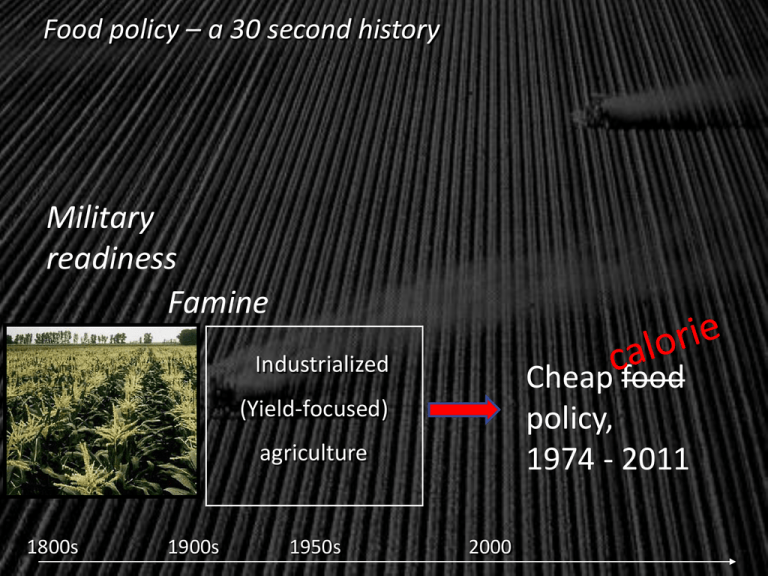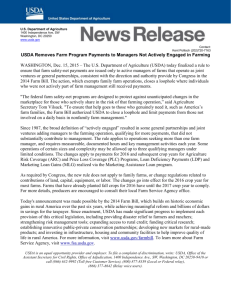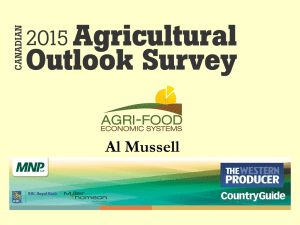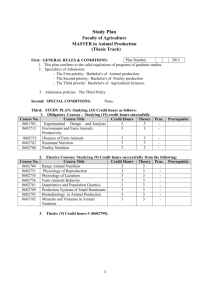Presentation 1 – PPT
advertisement

Food policy – a 30 second history Military readiness Famine Industrialized Cheap food policy, 1974 - 2011 (Yield-focused) agriculture 1800s 1900s 1950s 2000 U.S. food policy: Health “externalities” U.S. Crop Area Planted 2006 3% 6% 4% 29% 22% 1% 1% 2% 29% 1% Source: USDA Economic Research Service Corn Oats Barley Soybeans Sunflower Rice Wheat Cotton Sorghum Other U.S. food policy: Health “externalities” Americans overconsume cheap, overabundant calories in junk foods that are high in added fats and sugars. Diets rich in these foods contribute to obesity and other, expensive epidemic chronic dz. These calories are derived from the same few commodity crops supported by U.S. farm policy for decades. Source: Wallinga D. Agricultural Policy And Childhood Obesity: A Food Systems And Public Health Commentary. Health Affairs 2010; 29(3): 404–409 Farmers grow what Americans overconsume Percent increase in calorie intake, 1970 to 2007 400 359 350 300 260 250 200 191 150 100 50 69 14 0 From corn flour, Added sugars meal, hominy, starch Corn sweeteners Added fats and oils Salad and cooking oils Economic Research Service. Loss adjusted food availability [database on the Internet]. Washington (DC): U.S. Department of Agriculture; updated 2009 Feb [cited 10 Jan 2010]. Available from: http://www.ers .usda.gov/Data/FoodConsumption/ FoodGuideIndex.htm Other “externalities” Changing frames Healthy behaviors Default environments Focus on individuals PSE (Policy, Social, Environment) Public health Public environmental health nutrition Brownell KD, et al. The Need for Bold Action to Prevent Adolescent Obesity, Journal of Adolescent Health, 45 (2009) S8–S17. Brownell et al., Health Affairs 2010 Parker et al. IOM 2009 Changing frames A food systems perspective Healthy food systems Healthier eating environments Farm & food policy . Behavior Change Intensive water, soil use Energy use & climate change Antibiotic, hormone use Rising, pesticide, fertilizer use Story M, Hamm MW, Wallinga D, eds. Food Systems and Public Health: Linkages to Achieve Healthier Diets and Healthier Communities (suppl) Journal of Hunger & Environmental Nutrition, Volume 4, Issues 3 & 4. December 2009 (in press) Why the Farm Bill? It’s a very, big pie Farm programs 26.7% • 673 pages • $284b • every 5 years Nutrition programs 73.3% At Enactment: 2008 Farm Bill Distribution of Mandatory Spending, 2008-2017 CRS: http://www.nationalaglawcenter.org/assets/crs/RL34696.pdf 2008 Food, Conservation & Energy Act • 15 Titles – – – – – – – – Title I: Commodities Title II: Conservation Title IV: Nutrition Title VI: Rural Development Title VII: Research Title IX: Energy Title X: Hort & Organic Ag Title XII: Crop Insurance • No health title • No health jurisdiction • No overiding Nutrition health goal (SNAP) Poverty alleviation (SNAP) Summary at: www.ers.usda.gov/farmbill/2008 Health in the Farm Bill Courtesy of Roni Neff, PhD, Johns Hopkins University Bloomberg School of Public Health 1. What we eat – Access/affordability/production of healthy / sustainable / local & regional food – Support for commodities heavily used in less-healthy foods 2. Environmental health / sustainability – Conservation, organic and sustainable agriculture – Local/regional food systems – Support for agriculture with negative environmental impacts 3. Anti-hunger / food insecurity – Addressing food insecurity – domestic, international – Food security threats including due to unsustainable agriculture 4. Social disparities – – – – Access, affordability of healthy, sustainable, local/regional foods Leveling the playing field for small/midsized producers Rural public health, quality of life Distribution of Farm Bill funds Title I Support commodities • $5.2 billion/year • 84% to corn, soybeans, rice, wheat, cotton – Knowledge re yields, prices enables loans, financing, insurance, other risk mgt tools – Prohibits fruits/vegs on enrolled acres • Commodity support in other titles: crop insurance, marketing loans, disaster payments, research http://www.ers.usda.gov/BRIEFING/FarmPolicy/gallery/directpaymentmap1.gif Health in the Farm Bill (2008) Community food / Healthy food access • Fresh Fruit and Vegetable Snack Program $120m / yr • Farmers' Market Promotion Program $ 6.6m / yr • Healthy Incentives Pilot $20m • Specialty Crop Block Grants $55m / yr • Financing for Local Food Enterprises $50m / yr • Community Food Projects $5m / yr $250m Health in the Farm Bill 2008 • Change takes time 2012 • No enduring health coalition • Organizing new alliances was • Interested organizations --like NSAC, APHA, or Healthy Farms, effective, but required Healthy People Coalition – but nurturing lacking capacity for – Kellogg-funded Farm & Food Policy Project. Four core groups: EDF, AFT, CFSC, NEMW (not health) – Specialty Crop Farm Bill Alliance (more than 120 fruit and vegetable organizations) – National Sustainable Agriculture Coalition (80 organizations) Organizing new partnerships Health-focused and systemsfocused policy analysis • AGREE Not a health focus Near-term work?? Nationally, Globally Regionally Communities Institutions Households Change behavior, Treat disease Changing environments / Reducing disease Promoting health Food systems (PSE) change at all levels – Opportunities for partnership Nationally • National healthy food system research agenda • Farm Bill policy research and isssue advocacy Regionally Communities Institutions Households Change behavior, Treat disease • Major health organizations prioritize healthy food systems • New farmer financing • Regional, local food policy councils • Funding regional pilots of what works • Program related investments in healthy food infrastructure • Changing food systems in schools, hospitals, government buildings • Training for physicians around food systems











